Finance and Funding in Travel and Tourism: Financial Planning Report
VerifiedAdded on 2020/10/04
|19
|4617
|39
Report
AI Summary
This report delves into the crucial aspects of finance and funding within the travel and tourism industry, focusing on Akaglo Tours Company (ATC). It begins with a detailed examination of Cost-Volume-Profit (CVP) analysis, emphasizing its significance in financial planning and break-even analysis. The report then explores various pricing methods applicable to ATC's holiday packages, considering factors influencing profitability such as economic conditions, political factors, and costs. Furthermore, it analyzes different types of management accounting information, including financial statements, budgets, and variance analysis, providing insights into decision-making processes. The report also assesses investment appraisal techniques and interprets financial statements through ratio analysis. Finally, it explores potential sources of funds for developing a new hotel, offering practical recommendations for financial planning in the travel and tourism sector.
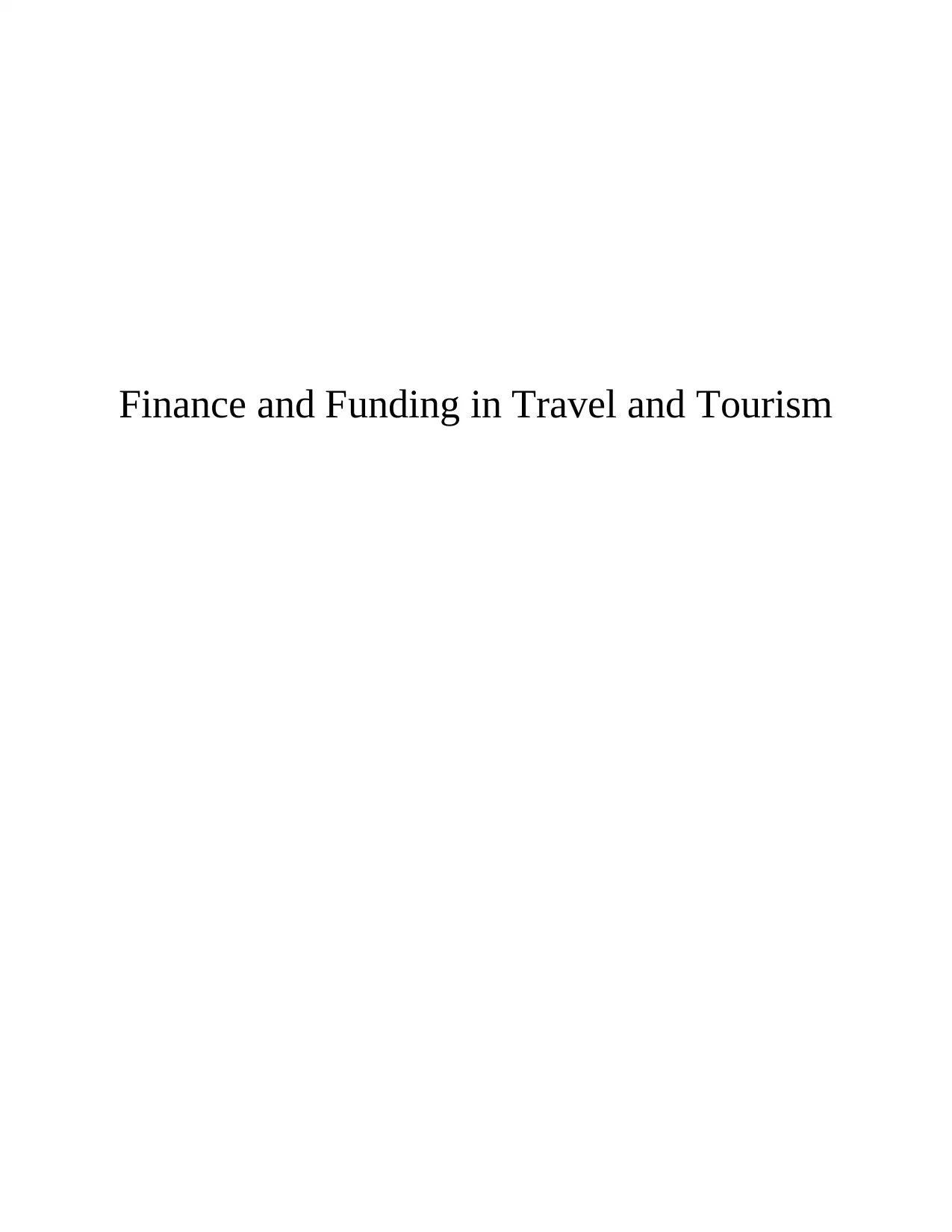
Finance and Funding in Travel and Tourism
Paraphrase This Document
Need a fresh take? Get an instant paraphrase of this document with our AI Paraphraser
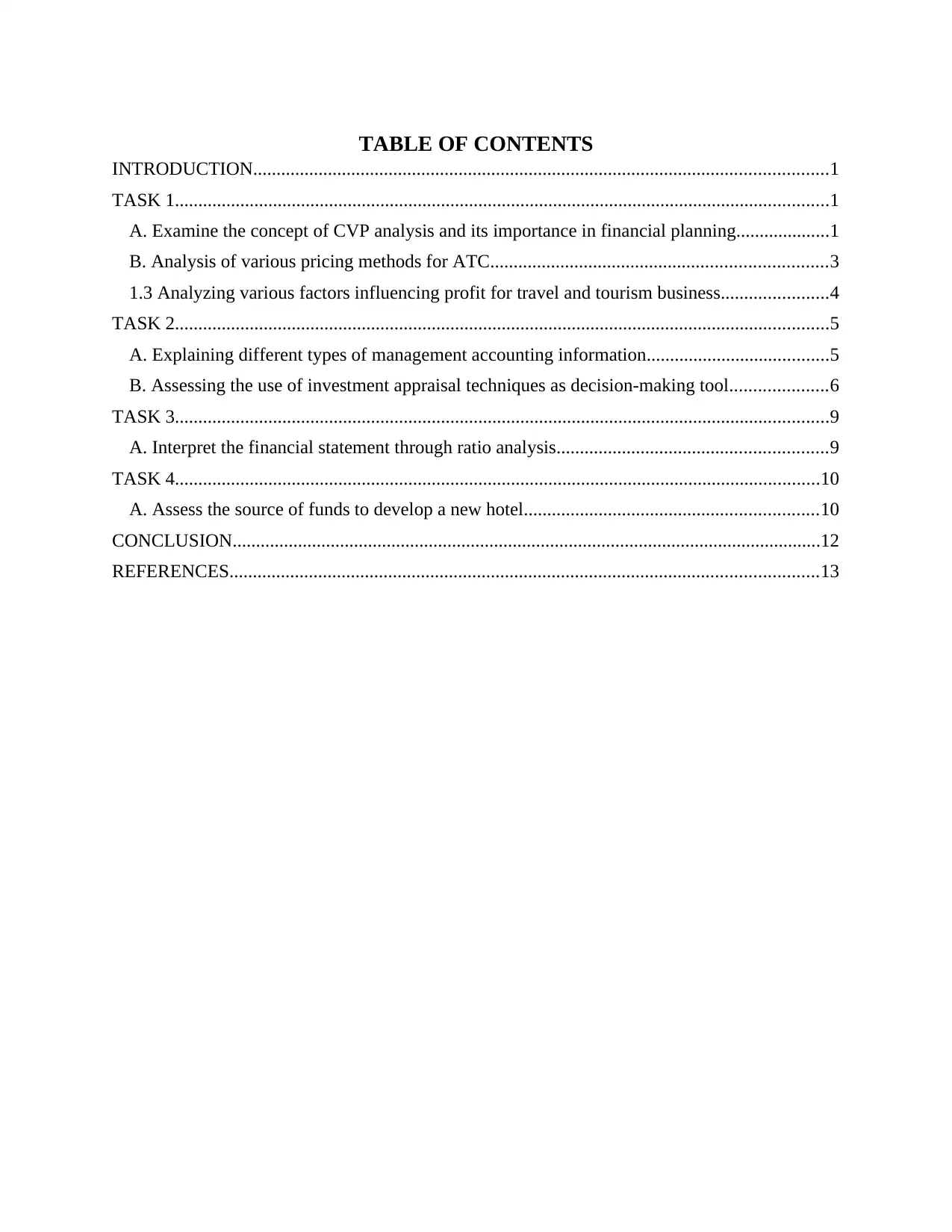
TABLE OF CONTENTS
INTRODUCTION...........................................................................................................................1
TASK 1............................................................................................................................................1
A. Examine the concept of CVP analysis and its importance in financial planning....................1
B. Analysis of various pricing methods for ATC........................................................................3
1.3 Analyzing various factors influencing profit for travel and tourism business.......................4
TASK 2............................................................................................................................................5
A. Explaining different types of management accounting information.......................................5
B. Assessing the use of investment appraisal techniques as decision-making tool.....................6
TASK 3............................................................................................................................................9
A. Interpret the financial statement through ratio analysis..........................................................9
TASK 4..........................................................................................................................................10
A. Assess the source of funds to develop a new hotel...............................................................10
CONCLUSION..............................................................................................................................12
REFERENCES..............................................................................................................................13
INTRODUCTION...........................................................................................................................1
TASK 1............................................................................................................................................1
A. Examine the concept of CVP analysis and its importance in financial planning....................1
B. Analysis of various pricing methods for ATC........................................................................3
1.3 Analyzing various factors influencing profit for travel and tourism business.......................4
TASK 2............................................................................................................................................5
A. Explaining different types of management accounting information.......................................5
B. Assessing the use of investment appraisal techniques as decision-making tool.....................6
TASK 3............................................................................................................................................9
A. Interpret the financial statement through ratio analysis..........................................................9
TASK 4..........................................................................................................................................10
A. Assess the source of funds to develop a new hotel...............................................................10
CONCLUSION..............................................................................................................................12
REFERENCES..............................................................................................................................13
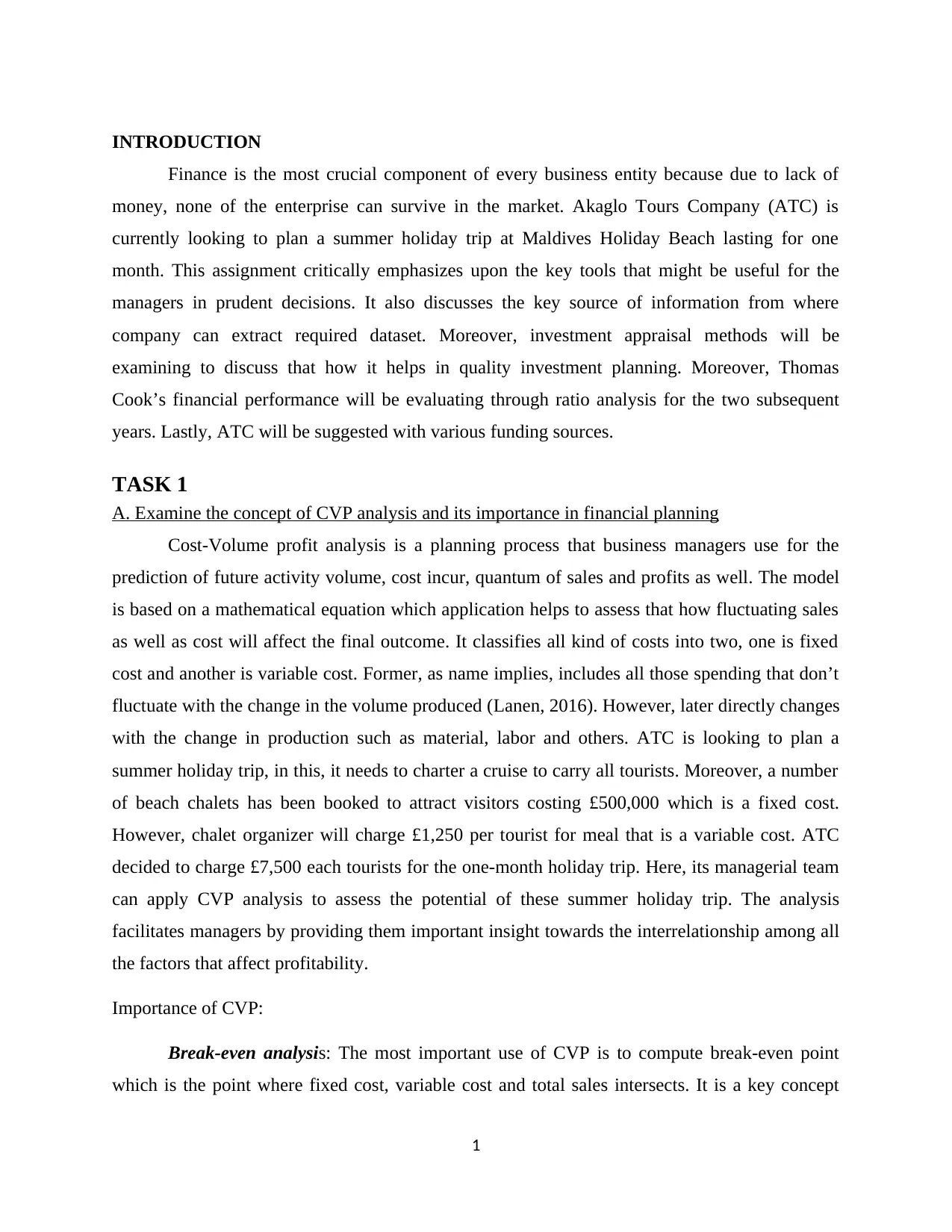
INTRODUCTION
Finance is the most crucial component of every business entity because due to lack of
money, none of the enterprise can survive in the market. Akaglo Tours Company (ATC) is
currently looking to plan a summer holiday trip at Maldives Holiday Beach lasting for one
month. This assignment critically emphasizes upon the key tools that might be useful for the
managers in prudent decisions. It also discusses the key source of information from where
company can extract required dataset. Moreover, investment appraisal methods will be
examining to discuss that how it helps in quality investment planning. Moreover, Thomas
Cook’s financial performance will be evaluating through ratio analysis for the two subsequent
years. Lastly, ATC will be suggested with various funding sources.
TASK 1
A. Examine the concept of CVP analysis and its importance in financial planning
Cost-Volume profit analysis is a planning process that business managers use for the
prediction of future activity volume, cost incur, quantum of sales and profits as well. The model
is based on a mathematical equation which application helps to assess that how fluctuating sales
as well as cost will affect the final outcome. It classifies all kind of costs into two, one is fixed
cost and another is variable cost. Former, as name implies, includes all those spending that don’t
fluctuate with the change in the volume produced (Lanen, 2016). However, later directly changes
with the change in production such as material, labor and others. ATC is looking to plan a
summer holiday trip, in this, it needs to charter a cruise to carry all tourists. Moreover, a number
of beach chalets has been booked to attract visitors costing £500,000 which is a fixed cost.
However, chalet organizer will charge £1,250 per tourist for meal that is a variable cost. ATC
decided to charge £7,500 each tourists for the one-month holiday trip. Here, its managerial team
can apply CVP analysis to assess the potential of these summer holiday trip. The analysis
facilitates managers by providing them important insight towards the interrelationship among all
the factors that affect profitability.
Importance of CVP:
Break-even analysis: The most important use of CVP is to compute break-even point
which is the point where fixed cost, variable cost and total sales intersects. It is a key concept
1
Finance is the most crucial component of every business entity because due to lack of
money, none of the enterprise can survive in the market. Akaglo Tours Company (ATC) is
currently looking to plan a summer holiday trip at Maldives Holiday Beach lasting for one
month. This assignment critically emphasizes upon the key tools that might be useful for the
managers in prudent decisions. It also discusses the key source of information from where
company can extract required dataset. Moreover, investment appraisal methods will be
examining to discuss that how it helps in quality investment planning. Moreover, Thomas
Cook’s financial performance will be evaluating through ratio analysis for the two subsequent
years. Lastly, ATC will be suggested with various funding sources.
TASK 1
A. Examine the concept of CVP analysis and its importance in financial planning
Cost-Volume profit analysis is a planning process that business managers use for the
prediction of future activity volume, cost incur, quantum of sales and profits as well. The model
is based on a mathematical equation which application helps to assess that how fluctuating sales
as well as cost will affect the final outcome. It classifies all kind of costs into two, one is fixed
cost and another is variable cost. Former, as name implies, includes all those spending that don’t
fluctuate with the change in the volume produced (Lanen, 2016). However, later directly changes
with the change in production such as material, labor and others. ATC is looking to plan a
summer holiday trip, in this, it needs to charter a cruise to carry all tourists. Moreover, a number
of beach chalets has been booked to attract visitors costing £500,000 which is a fixed cost.
However, chalet organizer will charge £1,250 per tourist for meal that is a variable cost. ATC
decided to charge £7,500 each tourists for the one-month holiday trip. Here, its managerial team
can apply CVP analysis to assess the potential of these summer holiday trip. The analysis
facilitates managers by providing them important insight towards the interrelationship among all
the factors that affect profitability.
Importance of CVP:
Break-even analysis: The most important use of CVP is to compute break-even point
which is the point where fixed cost, variable cost and total sales intersects. It is a key concept
1
⊘ This is a preview!⊘
Do you want full access?
Subscribe today to unlock all pages.

Trusted by 1+ million students worldwide
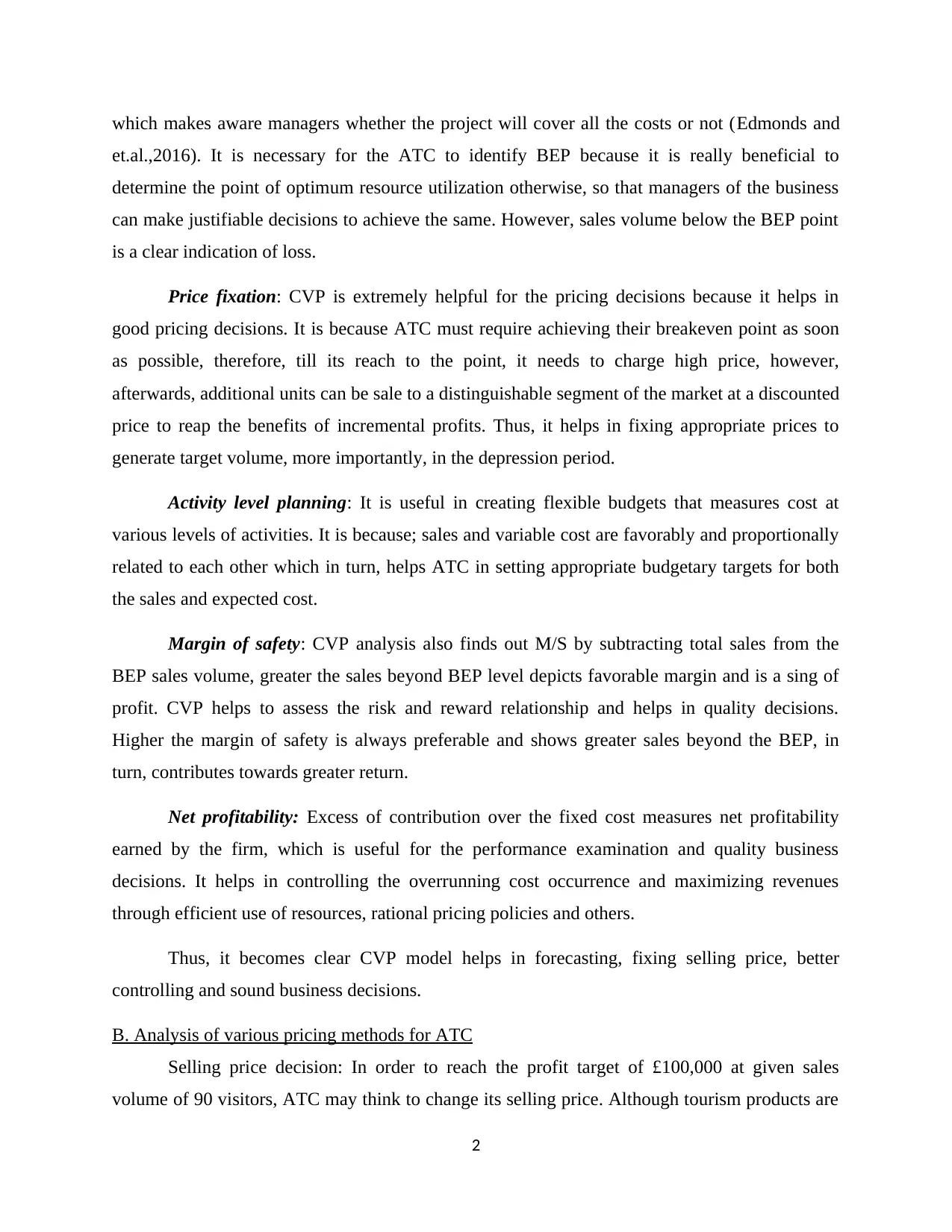
which makes aware managers whether the project will cover all the costs or not (Edmonds and
et.al.,2016). It is necessary for the ATC to identify BEP because it is really beneficial to
determine the point of optimum resource utilization otherwise, so that managers of the business
can make justifiable decisions to achieve the same. However, sales volume below the BEP point
is a clear indication of loss.
Price fixation: CVP is extremely helpful for the pricing decisions because it helps in
good pricing decisions. It is because ATC must require achieving their breakeven point as soon
as possible, therefore, till its reach to the point, it needs to charge high price, however,
afterwards, additional units can be sale to a distinguishable segment of the market at a discounted
price to reap the benefits of incremental profits. Thus, it helps in fixing appropriate prices to
generate target volume, more importantly, in the depression period.
Activity level planning: It is useful in creating flexible budgets that measures cost at
various levels of activities. It is because; sales and variable cost are favorably and proportionally
related to each other which in turn, helps ATC in setting appropriate budgetary targets for both
the sales and expected cost.
Margin of safety: CVP analysis also finds out M/S by subtracting total sales from the
BEP sales volume, greater the sales beyond BEP level depicts favorable margin and is a sing of
profit. CVP helps to assess the risk and reward relationship and helps in quality decisions.
Higher the margin of safety is always preferable and shows greater sales beyond the BEP, in
turn, contributes towards greater return.
Net profitability: Excess of contribution over the fixed cost measures net profitability
earned by the firm, which is useful for the performance examination and quality business
decisions. It helps in controlling the overrunning cost occurrence and maximizing revenues
through efficient use of resources, rational pricing policies and others.
Thus, it becomes clear CVP model helps in forecasting, fixing selling price, better
controlling and sound business decisions.
B. Analysis of various pricing methods for ATC
Selling price decision: In order to reach the profit target of £100,000 at given sales
volume of 90 visitors, ATC may think to change its selling price. Although tourism products are
2
et.al.,2016). It is necessary for the ATC to identify BEP because it is really beneficial to
determine the point of optimum resource utilization otherwise, so that managers of the business
can make justifiable decisions to achieve the same. However, sales volume below the BEP point
is a clear indication of loss.
Price fixation: CVP is extremely helpful for the pricing decisions because it helps in
good pricing decisions. It is because ATC must require achieving their breakeven point as soon
as possible, therefore, till its reach to the point, it needs to charge high price, however,
afterwards, additional units can be sale to a distinguishable segment of the market at a discounted
price to reap the benefits of incremental profits. Thus, it helps in fixing appropriate prices to
generate target volume, more importantly, in the depression period.
Activity level planning: It is useful in creating flexible budgets that measures cost at
various levels of activities. It is because; sales and variable cost are favorably and proportionally
related to each other which in turn, helps ATC in setting appropriate budgetary targets for both
the sales and expected cost.
Margin of safety: CVP analysis also finds out M/S by subtracting total sales from the
BEP sales volume, greater the sales beyond BEP level depicts favorable margin and is a sing of
profit. CVP helps to assess the risk and reward relationship and helps in quality decisions.
Higher the margin of safety is always preferable and shows greater sales beyond the BEP, in
turn, contributes towards greater return.
Net profitability: Excess of contribution over the fixed cost measures net profitability
earned by the firm, which is useful for the performance examination and quality business
decisions. It helps in controlling the overrunning cost occurrence and maximizing revenues
through efficient use of resources, rational pricing policies and others.
Thus, it becomes clear CVP model helps in forecasting, fixing selling price, better
controlling and sound business decisions.
B. Analysis of various pricing methods for ATC
Selling price decision: In order to reach the profit target of £100,000 at given sales
volume of 90 visitors, ATC may think to change its selling price. Although tourism products are
2
Paraphrase This Document
Need a fresh take? Get an instant paraphrase of this document with our AI Paraphraser
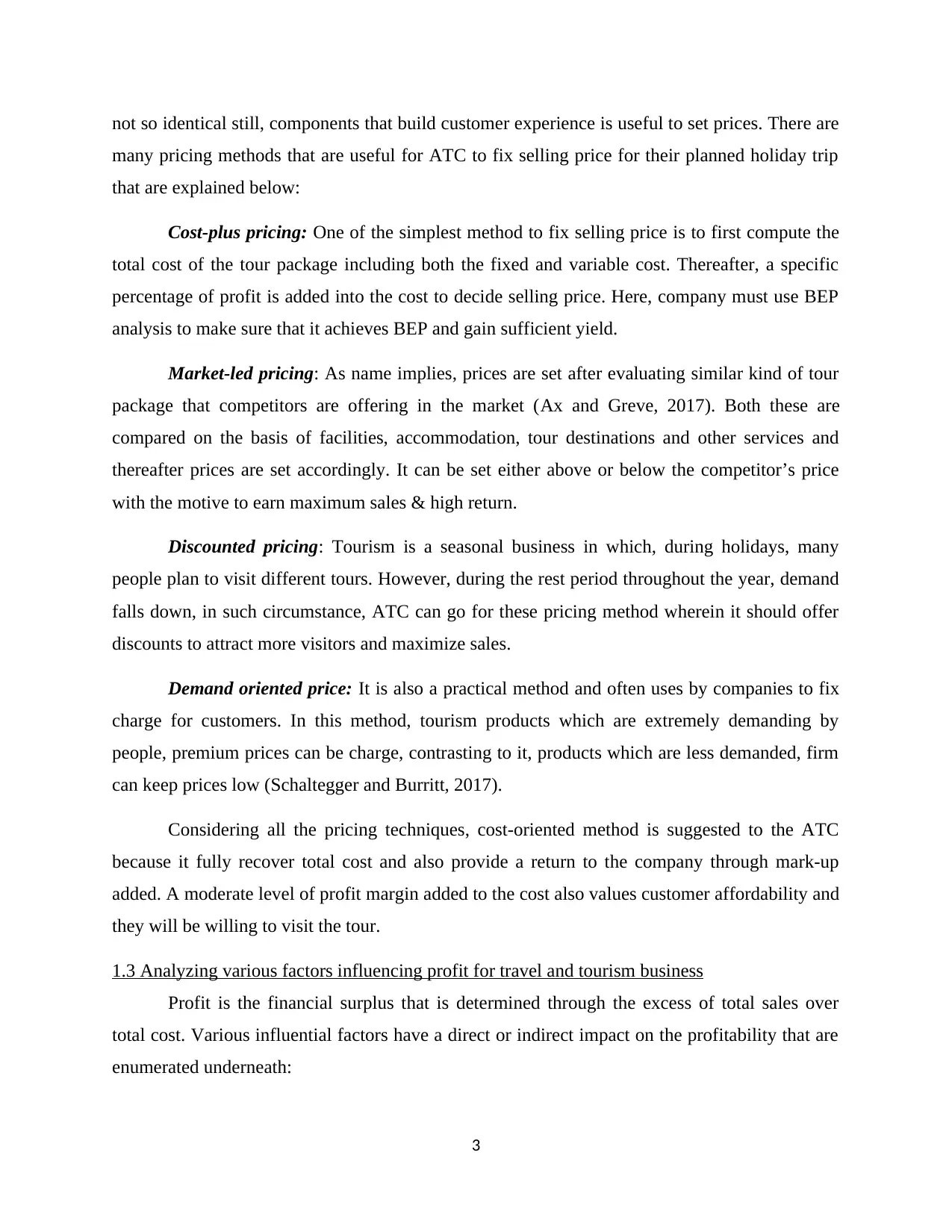
not so identical still, components that build customer experience is useful to set prices. There are
many pricing methods that are useful for ATC to fix selling price for their planned holiday trip
that are explained below:
Cost-plus pricing: One of the simplest method to fix selling price is to first compute the
total cost of the tour package including both the fixed and variable cost. Thereafter, a specific
percentage of profit is added into the cost to decide selling price. Here, company must use BEP
analysis to make sure that it achieves BEP and gain sufficient yield.
Market-led pricing: As name implies, prices are set after evaluating similar kind of tour
package that competitors are offering in the market (Ax and Greve, 2017). Both these are
compared on the basis of facilities, accommodation, tour destinations and other services and
thereafter prices are set accordingly. It can be set either above or below the competitor’s price
with the motive to earn maximum sales & high return.
Discounted pricing: Tourism is a seasonal business in which, during holidays, many
people plan to visit different tours. However, during the rest period throughout the year, demand
falls down, in such circumstance, ATC can go for these pricing method wherein it should offer
discounts to attract more visitors and maximize sales.
Demand oriented price: It is also a practical method and often uses by companies to fix
charge for customers. In this method, tourism products which are extremely demanding by
people, premium prices can be charge, contrasting to it, products which are less demanded, firm
can keep prices low (Schaltegger and Burritt, 2017).
Considering all the pricing techniques, cost-oriented method is suggested to the ATC
because it fully recover total cost and also provide a return to the company through mark-up
added. A moderate level of profit margin added to the cost also values customer affordability and
they will be willing to visit the tour.
1.3 Analyzing various factors influencing profit for travel and tourism business
Profit is the financial surplus that is determined through the excess of total sales over
total cost. Various influential factors have a direct or indirect impact on the profitability that are
enumerated underneath:
3
many pricing methods that are useful for ATC to fix selling price for their planned holiday trip
that are explained below:
Cost-plus pricing: One of the simplest method to fix selling price is to first compute the
total cost of the tour package including both the fixed and variable cost. Thereafter, a specific
percentage of profit is added into the cost to decide selling price. Here, company must use BEP
analysis to make sure that it achieves BEP and gain sufficient yield.
Market-led pricing: As name implies, prices are set after evaluating similar kind of tour
package that competitors are offering in the market (Ax and Greve, 2017). Both these are
compared on the basis of facilities, accommodation, tour destinations and other services and
thereafter prices are set accordingly. It can be set either above or below the competitor’s price
with the motive to earn maximum sales & high return.
Discounted pricing: Tourism is a seasonal business in which, during holidays, many
people plan to visit different tours. However, during the rest period throughout the year, demand
falls down, in such circumstance, ATC can go for these pricing method wherein it should offer
discounts to attract more visitors and maximize sales.
Demand oriented price: It is also a practical method and often uses by companies to fix
charge for customers. In this method, tourism products which are extremely demanding by
people, premium prices can be charge, contrasting to it, products which are less demanded, firm
can keep prices low (Schaltegger and Burritt, 2017).
Considering all the pricing techniques, cost-oriented method is suggested to the ATC
because it fully recover total cost and also provide a return to the company through mark-up
added. A moderate level of profit margin added to the cost also values customer affordability and
they will be willing to visit the tour.
1.3 Analyzing various factors influencing profit for travel and tourism business
Profit is the financial surplus that is determined through the excess of total sales over
total cost. Various influential factors have a direct or indirect impact on the profitability that are
enumerated underneath:
3
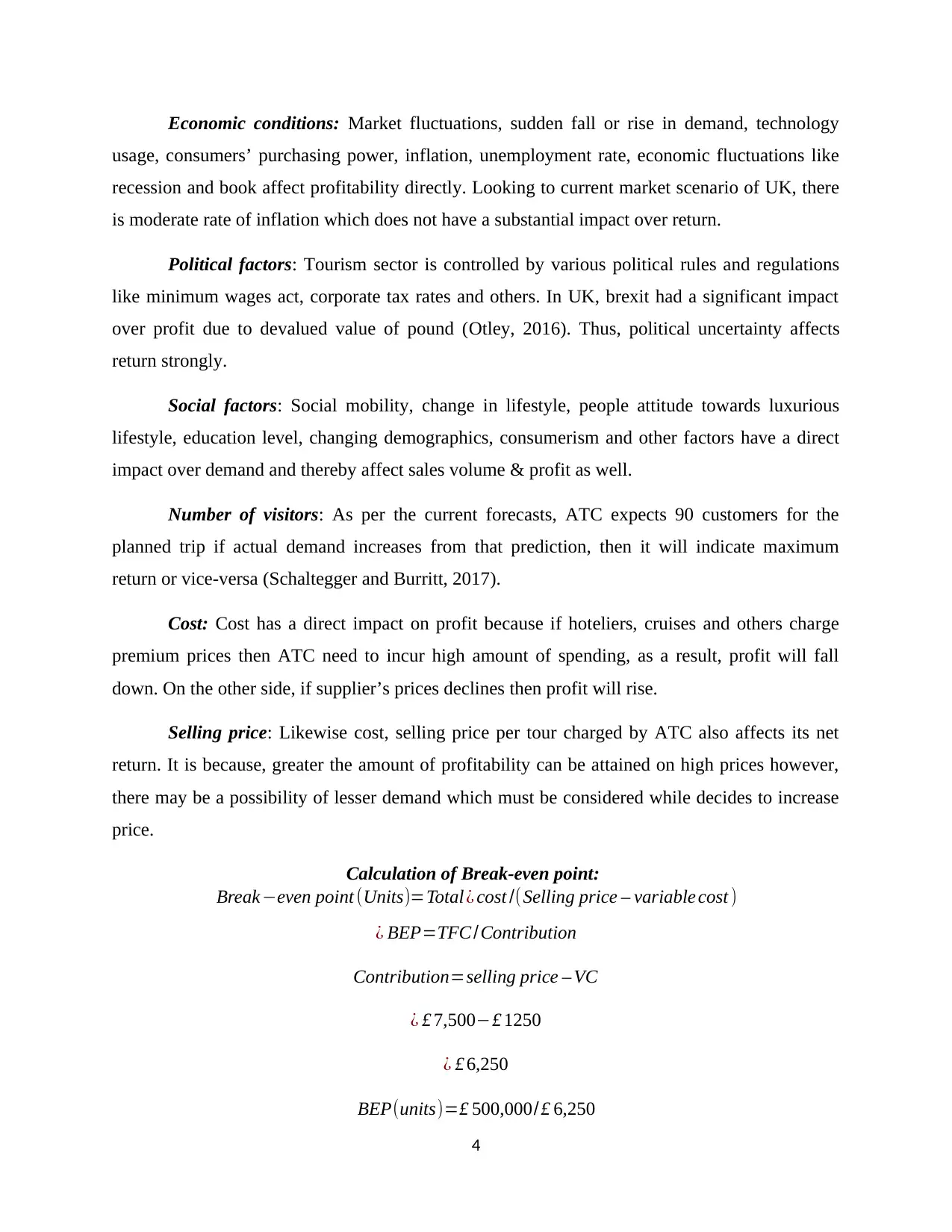
Economic conditions: Market fluctuations, sudden fall or rise in demand, technology
usage, consumers’ purchasing power, inflation, unemployment rate, economic fluctuations like
recession and book affect profitability directly. Looking to current market scenario of UK, there
is moderate rate of inflation which does not have a substantial impact over return.
Political factors: Tourism sector is controlled by various political rules and regulations
like minimum wages act, corporate tax rates and others. In UK, brexit had a significant impact
over profit due to devalued value of pound (Otley, 2016). Thus, political uncertainty affects
return strongly.
Social factors: Social mobility, change in lifestyle, people attitude towards luxurious
lifestyle, education level, changing demographics, consumerism and other factors have a direct
impact over demand and thereby affect sales volume & profit as well.
Number of visitors: As per the current forecasts, ATC expects 90 customers for the
planned trip if actual demand increases from that prediction, then it will indicate maximum
return or vice-versa (Schaltegger and Burritt, 2017).
Cost: Cost has a direct impact on profit because if hoteliers, cruises and others charge
premium prices then ATC need to incur high amount of spending, as a result, profit will fall
down. On the other side, if supplier’s prices declines then profit will rise.
Selling price: Likewise cost, selling price per tour charged by ATC also affects its net
return. It is because, greater the amount of profitability can be attained on high prices however,
there may be a possibility of lesser demand which must be considered while decides to increase
price.
Calculation of Break-even point:
Break−even point (Units)=Total ¿ cost /(Selling price – variable cost )
¿ BEP=TFC /Contribution
Contribution=selling price – VC
¿ £ 7,500−£ 1250
¿ £ 6,250
BEP(units)=£ 500,000/£ 6,250
4
usage, consumers’ purchasing power, inflation, unemployment rate, economic fluctuations like
recession and book affect profitability directly. Looking to current market scenario of UK, there
is moderate rate of inflation which does not have a substantial impact over return.
Political factors: Tourism sector is controlled by various political rules and regulations
like minimum wages act, corporate tax rates and others. In UK, brexit had a significant impact
over profit due to devalued value of pound (Otley, 2016). Thus, political uncertainty affects
return strongly.
Social factors: Social mobility, change in lifestyle, people attitude towards luxurious
lifestyle, education level, changing demographics, consumerism and other factors have a direct
impact over demand and thereby affect sales volume & profit as well.
Number of visitors: As per the current forecasts, ATC expects 90 customers for the
planned trip if actual demand increases from that prediction, then it will indicate maximum
return or vice-versa (Schaltegger and Burritt, 2017).
Cost: Cost has a direct impact on profit because if hoteliers, cruises and others charge
premium prices then ATC need to incur high amount of spending, as a result, profit will fall
down. On the other side, if supplier’s prices declines then profit will rise.
Selling price: Likewise cost, selling price per tour charged by ATC also affects its net
return. It is because, greater the amount of profitability can be attained on high prices however,
there may be a possibility of lesser demand which must be considered while decides to increase
price.
Calculation of Break-even point:
Break−even point (Units)=Total ¿ cost /(Selling price – variable cost )
¿ BEP=TFC /Contribution
Contribution=selling price – VC
¿ £ 7,500−£ 1250
¿ £ 6,250
BEP(units)=£ 500,000/£ 6,250
4
⊘ This is a preview!⊘
Do you want full access?
Subscribe today to unlock all pages.

Trusted by 1+ million students worldwide
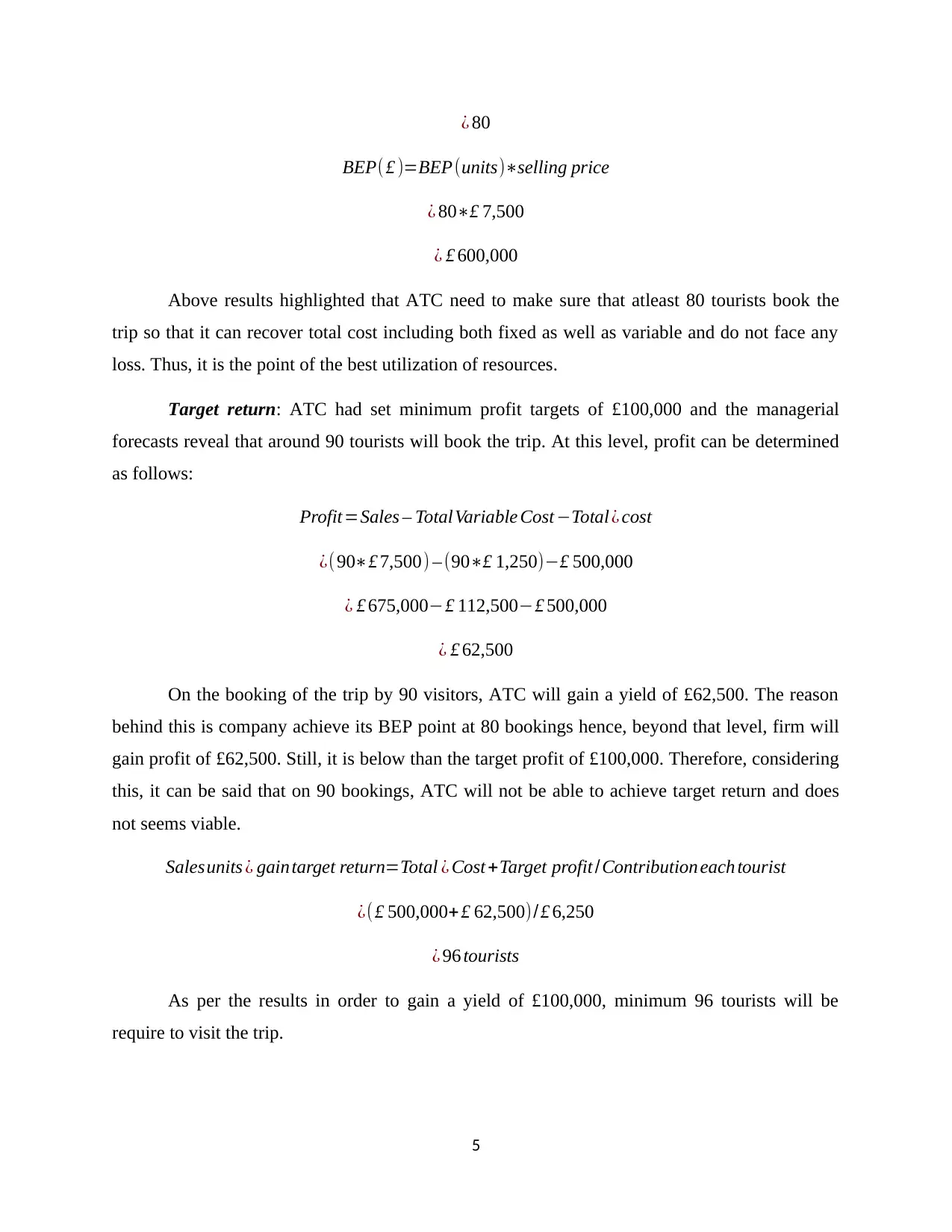
¿ 80
BEP( £ )=BEP (units)∗selling price
¿ 80∗£ 7,500
¿ £ 600,000
Above results highlighted that ATC need to make sure that atleast 80 tourists book the
trip so that it can recover total cost including both fixed as well as variable and do not face any
loss. Thus, it is the point of the best utilization of resources.
Target return: ATC had set minimum profit targets of £100,000 and the managerial
forecasts reveal that around 90 tourists will book the trip. At this level, profit can be determined
as follows:
Profit=Sales – TotalVariable Cost −Total ¿ cost
¿( 90∗£ 7,500) – (90∗£ 1,250)−£ 500,000
¿ £ 675,000−£ 112,500−£ 500,000
¿ £ 62,500
On the booking of the trip by 90 visitors, ATC will gain a yield of £62,500. The reason
behind this is company achieve its BEP point at 80 bookings hence, beyond that level, firm will
gain profit of £62,500. Still, it is below than the target profit of £100,000. Therefore, considering
this, it can be said that on 90 bookings, ATC will not be able to achieve target return and does
not seems viable.
Salesunits ¿ gaintarget return=Total ¿ Cost +Target profit /Contribution each tourist
¿(£ 500,000+£ 62,500)/£ 6,250
¿ 96 tourists
As per the results in order to gain a yield of £100,000, minimum 96 tourists will be
require to visit the trip.
5
BEP( £ )=BEP (units)∗selling price
¿ 80∗£ 7,500
¿ £ 600,000
Above results highlighted that ATC need to make sure that atleast 80 tourists book the
trip so that it can recover total cost including both fixed as well as variable and do not face any
loss. Thus, it is the point of the best utilization of resources.
Target return: ATC had set minimum profit targets of £100,000 and the managerial
forecasts reveal that around 90 tourists will book the trip. At this level, profit can be determined
as follows:
Profit=Sales – TotalVariable Cost −Total ¿ cost
¿( 90∗£ 7,500) – (90∗£ 1,250)−£ 500,000
¿ £ 675,000−£ 112,500−£ 500,000
¿ £ 62,500
On the booking of the trip by 90 visitors, ATC will gain a yield of £62,500. The reason
behind this is company achieve its BEP point at 80 bookings hence, beyond that level, firm will
gain profit of £62,500. Still, it is below than the target profit of £100,000. Therefore, considering
this, it can be said that on 90 bookings, ATC will not be able to achieve target return and does
not seems viable.
Salesunits ¿ gaintarget return=Total ¿ Cost +Target profit /Contribution each tourist
¿(£ 500,000+£ 62,500)/£ 6,250
¿ 96 tourists
As per the results in order to gain a yield of £100,000, minimum 96 tourists will be
require to visit the trip.
5
Paraphrase This Document
Need a fresh take? Get an instant paraphrase of this document with our AI Paraphraser
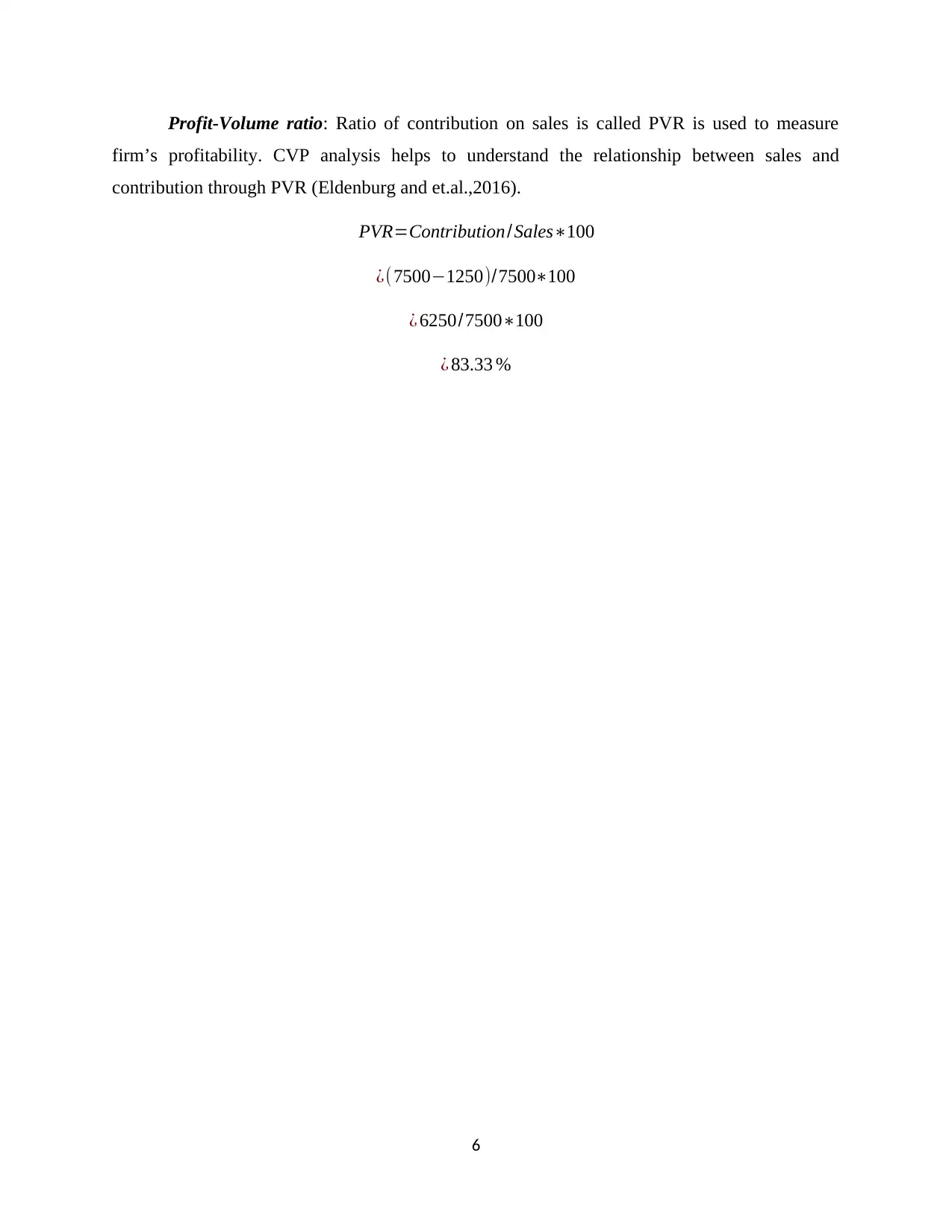
Profit-Volume ratio: Ratio of contribution on sales is called PVR is used to measure
firm’s profitability. CVP analysis helps to understand the relationship between sales and
contribution through PVR (Eldenburg and et.al.,2016).
PVR=Contribution /Sales∗100
¿(7500−1250)/7500∗100
¿ 6250/7500∗100
¿ 83.33 %
6
firm’s profitability. CVP analysis helps to understand the relationship between sales and
contribution through PVR (Eldenburg and et.al.,2016).
PVR=Contribution /Sales∗100
¿(7500−1250)/7500∗100
¿ 6250/7500∗100
¿ 83.33 %
6
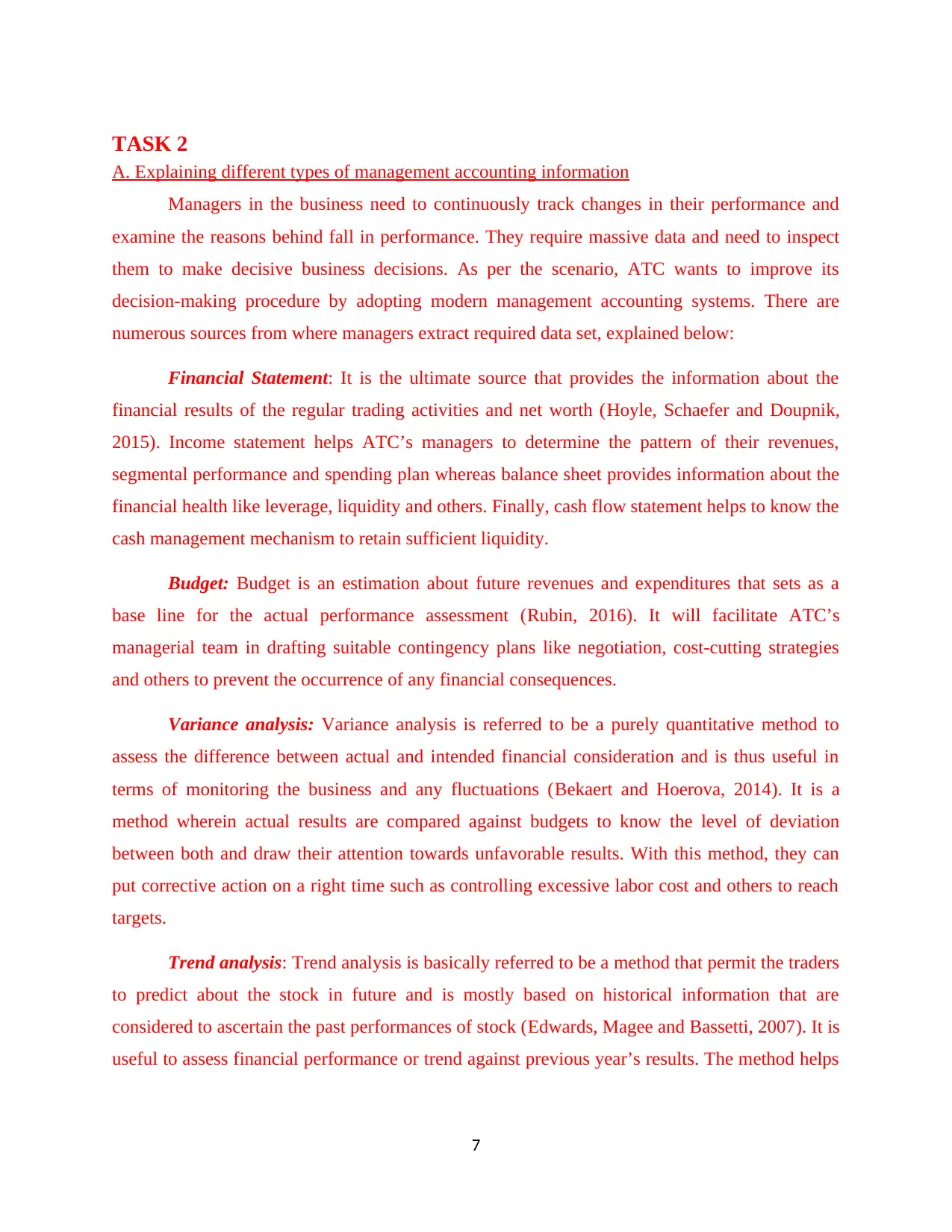
TASK 2
A. Explaining different types of management accounting information
Managers in the business need to continuously track changes in their performance and
examine the reasons behind fall in performance. They require massive data and need to inspect
them to make decisive business decisions. As per the scenario, ATC wants to improve its
decision-making procedure by adopting modern management accounting systems. There are
numerous sources from where managers extract required data set, explained below:
Financial Statement: It is the ultimate source that provides the information about the
financial results of the regular trading activities and net worth (Hoyle, Schaefer and Doupnik,
2015). Income statement helps ATC’s managers to determine the pattern of their revenues,
segmental performance and spending plan whereas balance sheet provides information about the
financial health like leverage, liquidity and others. Finally, cash flow statement helps to know the
cash management mechanism to retain sufficient liquidity.
Budget: Budget is an estimation about future revenues and expenditures that sets as a
base line for the actual performance assessment (Rubin, 2016). It will facilitate ATC’s
managerial team in drafting suitable contingency plans like negotiation, cost-cutting strategies
and others to prevent the occurrence of any financial consequences.
Variance analysis: Variance analysis is referred to be a purely quantitative method to
assess the difference between actual and intended financial consideration and is thus useful in
terms of monitoring the business and any fluctuations (Bekaert and Hoerova, 2014). It is a
method wherein actual results are compared against budgets to know the level of deviation
between both and draw their attention towards unfavorable results. With this method, they can
put corrective action on a right time such as controlling excessive labor cost and others to reach
targets.
Trend analysis: Trend analysis is basically referred to be a method that permit the traders
to predict about the stock in future and is mostly based on historical information that are
considered to ascertain the past performances of stock (Edwards, Magee and Bassetti, 2007). It is
useful to assess financial performance or trend against previous year’s results. The method helps
7
A. Explaining different types of management accounting information
Managers in the business need to continuously track changes in their performance and
examine the reasons behind fall in performance. They require massive data and need to inspect
them to make decisive business decisions. As per the scenario, ATC wants to improve its
decision-making procedure by adopting modern management accounting systems. There are
numerous sources from where managers extract required data set, explained below:
Financial Statement: It is the ultimate source that provides the information about the
financial results of the regular trading activities and net worth (Hoyle, Schaefer and Doupnik,
2015). Income statement helps ATC’s managers to determine the pattern of their revenues,
segmental performance and spending plan whereas balance sheet provides information about the
financial health like leverage, liquidity and others. Finally, cash flow statement helps to know the
cash management mechanism to retain sufficient liquidity.
Budget: Budget is an estimation about future revenues and expenditures that sets as a
base line for the actual performance assessment (Rubin, 2016). It will facilitate ATC’s
managerial team in drafting suitable contingency plans like negotiation, cost-cutting strategies
and others to prevent the occurrence of any financial consequences.
Variance analysis: Variance analysis is referred to be a purely quantitative method to
assess the difference between actual and intended financial consideration and is thus useful in
terms of monitoring the business and any fluctuations (Bekaert and Hoerova, 2014). It is a
method wherein actual results are compared against budgets to know the level of deviation
between both and draw their attention towards unfavorable results. With this method, they can
put corrective action on a right time such as controlling excessive labor cost and others to reach
targets.
Trend analysis: Trend analysis is basically referred to be a method that permit the traders
to predict about the stock in future and is mostly based on historical information that are
considered to ascertain the past performances of stock (Edwards, Magee and Bassetti, 2007). It is
useful to assess financial performance or trend against previous year’s results. The method helps
7
⊘ This is a preview!⊘
Do you want full access?
Subscribe today to unlock all pages.

Trusted by 1+ million students worldwide
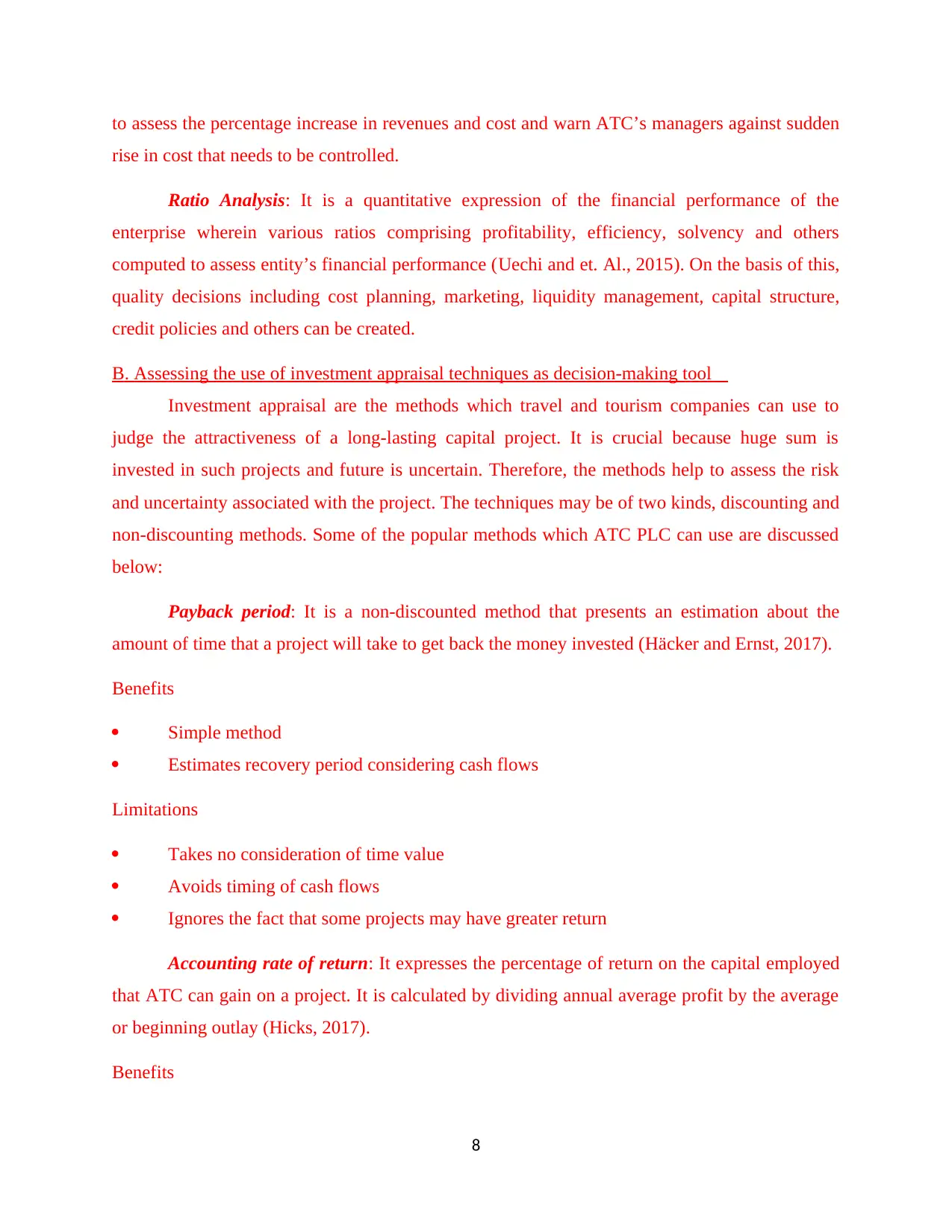
to assess the percentage increase in revenues and cost and warn ATC’s managers against sudden
rise in cost that needs to be controlled.
Ratio Analysis: It is a quantitative expression of the financial performance of the
enterprise wherein various ratios comprising profitability, efficiency, solvency and others
computed to assess entity’s financial performance (Uechi and et. Al., 2015). On the basis of this,
quality decisions including cost planning, marketing, liquidity management, capital structure,
credit policies and others can be created.
B. Assessing the use of investment appraisal techniques as decision-making tool
Investment appraisal are the methods which travel and tourism companies can use to
judge the attractiveness of a long-lasting capital project. It is crucial because huge sum is
invested in such projects and future is uncertain. Therefore, the methods help to assess the risk
and uncertainty associated with the project. The techniques may be of two kinds, discounting and
non-discounting methods. Some of the popular methods which ATC PLC can use are discussed
below:
Payback period: It is a non-discounted method that presents an estimation about the
amount of time that a project will take to get back the money invested (Häcker and Ernst, 2017).
Benefits
Simple method
Estimates recovery period considering cash flows
Limitations
Takes no consideration of time value
Avoids timing of cash flows
Ignores the fact that some projects may have greater return
Accounting rate of return: It expresses the percentage of return on the capital employed
that ATC can gain on a project. It is calculated by dividing annual average profit by the average
or beginning outlay (Hicks, 2017).
Benefits
8
rise in cost that needs to be controlled.
Ratio Analysis: It is a quantitative expression of the financial performance of the
enterprise wherein various ratios comprising profitability, efficiency, solvency and others
computed to assess entity’s financial performance (Uechi and et. Al., 2015). On the basis of this,
quality decisions including cost planning, marketing, liquidity management, capital structure,
credit policies and others can be created.
B. Assessing the use of investment appraisal techniques as decision-making tool
Investment appraisal are the methods which travel and tourism companies can use to
judge the attractiveness of a long-lasting capital project. It is crucial because huge sum is
invested in such projects and future is uncertain. Therefore, the methods help to assess the risk
and uncertainty associated with the project. The techniques may be of two kinds, discounting and
non-discounting methods. Some of the popular methods which ATC PLC can use are discussed
below:
Payback period: It is a non-discounted method that presents an estimation about the
amount of time that a project will take to get back the money invested (Häcker and Ernst, 2017).
Benefits
Simple method
Estimates recovery period considering cash flows
Limitations
Takes no consideration of time value
Avoids timing of cash flows
Ignores the fact that some projects may have greater return
Accounting rate of return: It expresses the percentage of return on the capital employed
that ATC can gain on a project. It is calculated by dividing annual average profit by the average
or beginning outlay (Hicks, 2017).
Benefits
8
Paraphrase This Document
Need a fresh take? Get an instant paraphrase of this document with our AI Paraphraser
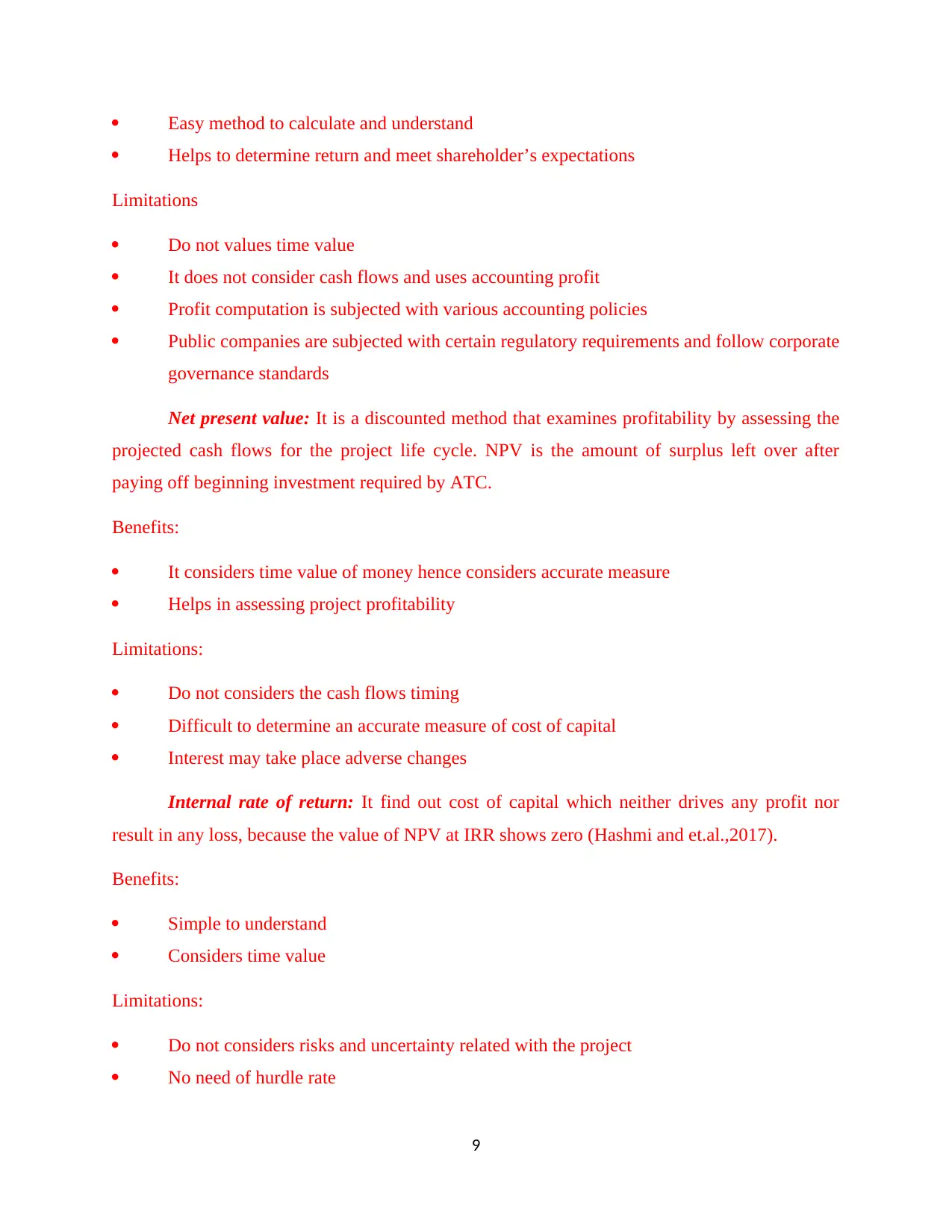
Easy method to calculate and understand
Helps to determine return and meet shareholder’s expectations
Limitations
Do not values time value
It does not consider cash flows and uses accounting profit
Profit computation is subjected with various accounting policies
Public companies are subjected with certain regulatory requirements and follow corporate
governance standards
Net present value: It is a discounted method that examines profitability by assessing the
projected cash flows for the project life cycle. NPV is the amount of surplus left over after
paying off beginning investment required by ATC.
Benefits:
It considers time value of money hence considers accurate measure
Helps in assessing project profitability
Limitations:
Do not considers the cash flows timing
Difficult to determine an accurate measure of cost of capital
Interest may take place adverse changes
Internal rate of return: It find out cost of capital which neither drives any profit nor
result in any loss, because the value of NPV at IRR shows zero (Hashmi and et.al.,2017).
Benefits:
Simple to understand
Considers time value
Limitations:
Do not considers risks and uncertainty related with the project
No need of hurdle rate
9
Helps to determine return and meet shareholder’s expectations
Limitations
Do not values time value
It does not consider cash flows and uses accounting profit
Profit computation is subjected with various accounting policies
Public companies are subjected with certain regulatory requirements and follow corporate
governance standards
Net present value: It is a discounted method that examines profitability by assessing the
projected cash flows for the project life cycle. NPV is the amount of surplus left over after
paying off beginning investment required by ATC.
Benefits:
It considers time value of money hence considers accurate measure
Helps in assessing project profitability
Limitations:
Do not considers the cash flows timing
Difficult to determine an accurate measure of cost of capital
Interest may take place adverse changes
Internal rate of return: It find out cost of capital which neither drives any profit nor
result in any loss, because the value of NPV at IRR shows zero (Hashmi and et.al.,2017).
Benefits:
Simple to understand
Considers time value
Limitations:
Do not considers risks and uncertainty related with the project
No need of hurdle rate
9

10
⊘ This is a preview!⊘
Do you want full access?
Subscribe today to unlock all pages.

Trusted by 1+ million students worldwide
1 out of 19
Related Documents
Your All-in-One AI-Powered Toolkit for Academic Success.
+13062052269
info@desklib.com
Available 24*7 on WhatsApp / Email
![[object Object]](/_next/static/media/star-bottom.7253800d.svg)
Unlock your academic potential
Copyright © 2020–2025 A2Z Services. All Rights Reserved. Developed and managed by ZUCOL.





